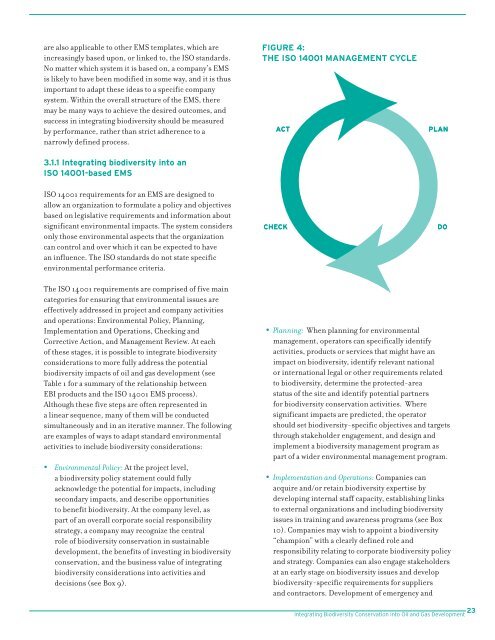Integrating Biodiversity Conservation into Oil and Gas ... - EBI
Integrating Biodiversity Conservation into Oil and Gas ... - EBI
Integrating Biodiversity Conservation into Oil and Gas ... - EBI
Create successful ePaper yourself
Turn your PDF publications into a flip-book with our unique Google optimized e-Paper software.
are also applicable to other EMS templates, which are<br />
increasingly based upon, or linked to, the ISO st<strong>and</strong>ards.<br />
No matter which system it is based on, a company’s EMS<br />
is likely to have been modified in some way, <strong>and</strong> it is thus<br />
important to adapt these ideas to a specific company<br />
system. Within the overall structure of the EMS, there<br />
may be many ways to achieve the desired outcomes, <strong>and</strong><br />
success in integrating biodiversity should be measured<br />
by performance, rather than strict adherence to a<br />
narrowly defined process.<br />
3.1.1 <strong>Integrating</strong> biodiversity <strong>into</strong> an<br />
ISO 14001-based EMS<br />
ISO 14001 requirements for an EMS are designed to<br />
allow an organization to formulate a policy <strong>and</strong> objectives<br />
based on legislative requirements <strong>and</strong> information about<br />
significant environmental impacts. The system considers<br />
only those environmental aspects that the organization<br />
can control <strong>and</strong> over which it can be expected to have<br />
an influence. The ISO st<strong>and</strong>ards do not state specific<br />
environmental performance criteria.<br />
FIGURE 4:<br />
THE ISO 14001 MANAGEMENT CYCLE<br />
ACT<br />
CHECK<br />
PLAN<br />
DO<br />
The ISO 14001 requirements are comprised of five main<br />
categories for ensuring that environmental issues are<br />
effectively addressed in project <strong>and</strong> company activities<br />
<strong>and</strong> operations: Environmental Policy, Planning,<br />
Implementation <strong>and</strong> Operations, Checking <strong>and</strong><br />
Corrective Action, <strong>and</strong> Management Review. At each<br />
of these stages, it is possible to integrate biodiversity<br />
considerations to more fully address the potential<br />
biodiversity impacts of oil <strong>and</strong> gas development (see<br />
Table 1 for a summary of the relationship between<br />
<strong>EBI</strong> products <strong>and</strong> the ISO 14001 EMS process).<br />
Although these five steps are often represented in<br />
a linear sequence, many of them will be conducted<br />
simultaneously <strong>and</strong> in an iterative manner. The following<br />
are examples of ways to adapt st<strong>and</strong>ard environmental<br />
activities to include biodiversity considerations:<br />
• Environmental Policy: At the project level,<br />
a biodiversity policy statement could fully<br />
acknowledge the potential for impacts, including<br />
secondary impacts, <strong>and</strong> describe opportunities<br />
to benefit biodiversity. At the company level, as<br />
part of an overall corporate social responsibility<br />
strategy, a company may recognize the central<br />
role of biodiversity conservation in sustainable<br />
development, the benefits of investing in biodiversity<br />
conservation, <strong>and</strong> the business value of integrating<br />
biodiversity considerations <strong>into</strong> activities <strong>and</strong><br />
decisions (see Box 9).<br />
• Planning: When planning for environmental<br />
management, operators can specifically identify<br />
activities, products or services that might have an<br />
impact on biodiversity, identify relevant national<br />
or international legal or other requirements related<br />
to biodiversity, determine the protected-area<br />
status of the site <strong>and</strong> identify potential partners<br />
for biodiversity conservation activities. Where<br />
significant impacts are predicted, the operator<br />
should set biodiversity-specific objectives <strong>and</strong> targets<br />
through stakeholder engagement, <strong>and</strong> design <strong>and</strong><br />
implement a biodiversity management program as<br />
part of a wider environmental management program.<br />
• Implementation <strong>and</strong> Operations: Companies can<br />
acquire <strong>and</strong>/or retain biodiversity expertise by<br />
developing internal staff capacity, establishing links<br />
to external organizations <strong>and</strong> including biodiversity<br />
issues in training <strong>and</strong> awareness programs (see Box<br />
10). Companies may wish to appoint a biodiversity<br />
“champion” with a clearly defined role <strong>and</strong><br />
responsibility relating to corporate biodiversity policy<br />
<strong>and</strong> strategy. Companies can also engage stakeholders<br />
at an early stage on biodiversity issues <strong>and</strong> develop<br />
biodiversity-specific requirements for suppliers<br />
<strong>and</strong> contractors. Development of emergency <strong>and</strong><br />
23<br />
<strong>Integrating</strong> <strong>Biodiversity</strong> <strong>Conservation</strong> <strong>into</strong> <strong>Oil</strong> <strong>and</strong> <strong>Gas</strong> Development
















![[PDF] Community Development Toolkit - CommDev](https://img.yumpu.com/48616495/1/184x260/pdf-community-development-toolkit-commdev.jpg?quality=85)
